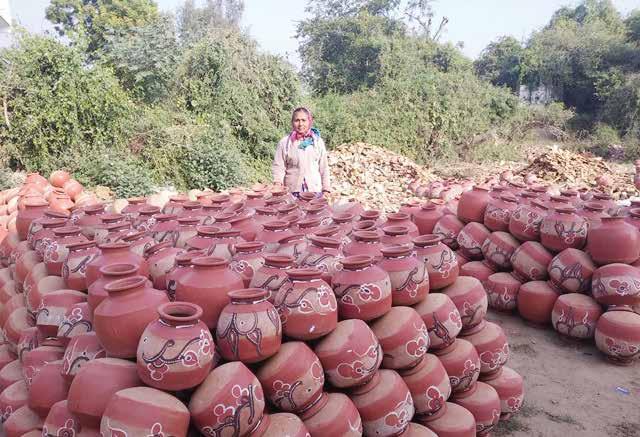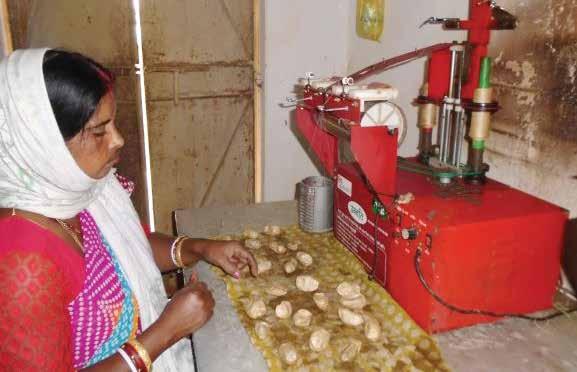29 operate for 10 hours every day, with smaller units producing up to 100–150 articles, medium units producing up to 200–300 articles, and larger units producing around 500–600 articles a day. The monthly production capacity also varies depending on the demand and the size of the enterprise. Each unit generates monthly revenue in the range of INR 30,000 to INR 1.5 lakh per month based on their level of productions.
Production process Wood from Hale Mara tree, also known as ivory wood or soft wood, is cut into small-sized chunks or billets, and kept aside for ‘seasoning’ to remove moisture. The seasoned wood is again cut into small pieces of required length by a cutter, which is further shaped by a ‘Lathe’, a mechanical device used for rotating wood using chisels. The toys are coloured using lac. A lac stick of a chosen colour is pressed onto the rotating wood; due to friction, the lac melts and gets coated on the wood surface. A dried palm leaf is used to spread the applied lac uniformly over the surface and rendering the product a lustrous appearance.
Energy consumption A lathe machine, circular cutters or band saws, and drilling machines are some of the motorized equipment used in toy production in this region, which are run for around 10 hours a day. The cumulative energy consumption of the motors is 2 HP, 6.5 HP, and 10 HP for small, medium and big units, respectively. There is no reported shortage of grid electricity, barring rare short outages. The average monthly electricity bill has been checked for all different units and the details have been provided in Table 4.
Like in other clusters, entrepreneurs in Channapatna are interested to explore the option of solar to power their production activities and are willing to contribute 20–30% of the system cost from their end.
Design of solar PV For this cluster, TERI proposes grid-connected solar systems (without battery back-up) for small, medium, and large capacity units of toy making that will power the machineries for woodworking. The design of the system has been done considering space constraint and investment capacity of the studied cluster. Thus, it has been assumed that 50% of the energy will be met through solar and the balance 50% will be met through the grid.
In the small unit, a grid-fed individual solar PV system with capacity of 3 kWp, in medium units, a grid-fed individual solar PV system with capacity of 6 kWp, whereas in the large unit, a grid-fed individual solar PV system with capacity of 14 kW will be required to meet the power needs. The area requirements for the installation of solar PV systems in the small medium, and large plants are 20 m2, 40 m2, and 95 m2, and the systems’ costs (calculated using MNRE benchmark prices – INR 54 per Wp and INR 48 per Wp) would be INR 162,000, INR 324,000, and INR 672,000, respectively.
Proposed business model For this study, the micro-enterprise units in Ramnagara–Channapatna wooden toy cluster have been segregated into three categories (small: 3 kWp system, medium-6 kWp system, and
TABLE 4: Electricity bills of powerloom units
Categorization of power loom unit
Average monthly electricity expenses (INR)
Large (up to 6 lathe/unit)
11,000 to 11,500
Medium (up to 4 lathe/unit)
5000 to 5500
Small (up to 2 lathe/unit)
2000 to 2500






